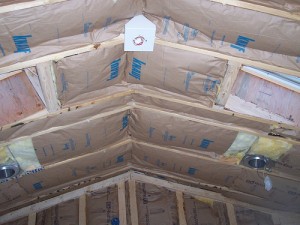 One of the biggest ways to waste money is to run the furnace or air conditioner more than necessary. Without proper insulation, all the heat or cool air generated goes right outside. This just causes the appliance to work harder racking up a large utility bill for the homeowner. With a little sweat, and some cash outlay, insulation can be fortified, and the heat loss reduced to a minimum.
One of the biggest ways to waste money is to run the furnace or air conditioner more than necessary. Without proper insulation, all the heat or cool air generated goes right outside. This just causes the appliance to work harder racking up a large utility bill for the homeowner. With a little sweat, and some cash outlay, insulation can be fortified, and the heat loss reduced to a minimum.
The basic function of insulation is to slow the transfer of heat. So in the winter, we naturally want the heat to stay inside the house and not go outside. In the summer, it is just the opposite. By providing the insulating barrier between the two zones, the comfortable temperature air is kept inside the house (great article describing the properties of heat flow here). There are three main types of insulation, but the important thing to keep in mind is the R-Value. The higher the R-value, the more efficient the insulation will be.
Blanket Insulation
Most people imagine blanket insulation when they think of insulating a house. The fiberglass batting, usually attached to a waterproof paper, that is rolled out between the rafters and wall studs makes up the majority of what is used. It is cheap, effective, and easy to install.
Loose Fill
Many attics are blown with loose fill insulation. If the attic is not used, this insulation is simply blown in providing many air pockets, and makes for an excellent heat trap. It requires special machinery (which can be rented) and a little more effort, so most people leave the installation up to the professionals.
Foam
Foam can come in two different styles. Spray foam is found in aerosol cans, often under the brand name Great Stuff. Perfect for getting into those tiny little cracks around doors and windows, this insulation is quick and easy. For larger projects, spray foam offers one of the best R-values, but also requires a professional and comes with a hefty price tag. Styrofoam is used widely as a cheaper, easier alternative.
There are many tradeoffs when it comes to upgrading the insulation in a home. If you are handy and can easily access the area, the cost is not very high at all. A few hours on the weekend and the next utility bill should be noticeably smaller. If the attic is too hard to get to, but the basement is unfinished, the savings will be less, but the man-hours into the project will be as well. The bottom line is all walls and ceilings that do not have insulation need at least some.
The payoff for upgrading insulation is long-term. The costs will all come out up front, but the savings will flow in month after month. The dollar savings on utilities are not the only things that should be counted though. The house will be more comfortable, the furnace and air conditioner will last longer due to less stress on their components, and the value of the house will go up. After a few years of living in a house with upgraded insulation, you will wonder why you put up with it for so long before remedying the situation.

Our home is ancient in terms of insulation. Fortunately, our electric bill the last several months has been less than $40! So we’re not losing too much money to it.
This is also because we don’t use the second floor of our home much (my office is up there, so I use it a few times a week). If we do end up using the second floor more, we will definitely need to insulate the attic.